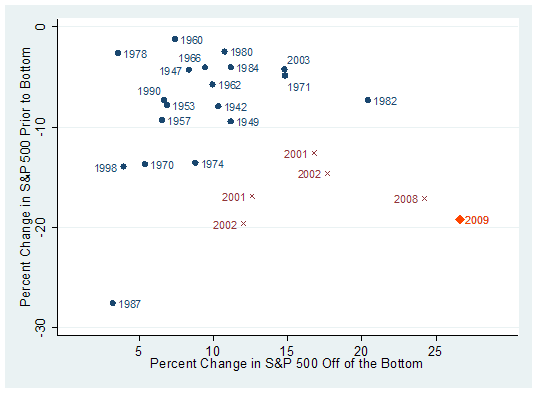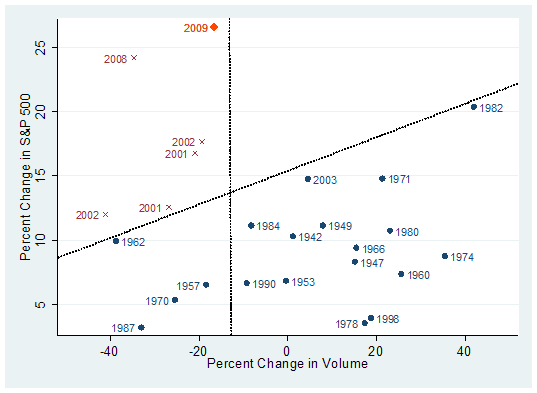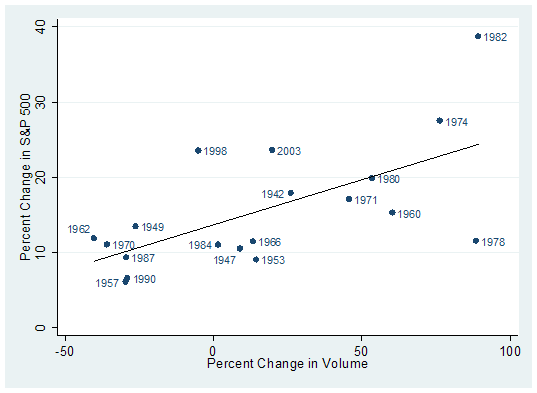Cycle RevisitedBy
Howard Ruff, The Ruff Times | 28 April 2009 - John Williams publishes the Shadow Government Statistics newsletter (www.shadowstats.com). He is an amazing professional economist with a great grasp of the real economy. He and I have arrived at the same conclusions about almost everything in the economy, despite the fact that we approach it from totally different directions: me from the fundamentals, and he from a real technical and numbers point of view.
I am now in John’s home in Oakland, California, looking past the government numbers to get his views on the world as it really is. Shadow Government Statistics reconstructs published government statistics the accurate way we used to do it that reflects reality, rather than the way these numbers are now manipulated, and comes up with different conclusions about the economy, such as the Consumer Price Index (CPI), and other revealing areas published by government.
I trust John’s numbers because the government has been manipulating and restating these numbers for purely political purposes.
|
HJR: John is it necessary to recreate government statistics to show what you feel is reality, and how you have recreated them? I’d like some examples.JW: Howard, I’ve been a consulting economist for about 27 years. I found early on that to make meaningful forecasts I had to have accurate information. It was evident early on that there were big inaccuracies in government reporting that I surveyed, e.g., at conventios of the National Association of Business Economists.
Some economists have to make real-world forecasts, as opposed to those economists employed by Wall Street to come to up with 'happy stories' to encourage people to buy stocks and bonds.I asked them what they considered the quality of government statistics to be. Most thought the numbers were very poor quality. And, political manipulation of the numbers tends to increase in election years.
I talked to the chief economist for a large retail chain, and he told me that the retail sales reports were absolutely no good, but he thought the money-supply numbers were pretty good.Next was an economist for a major bank. He said the money-supply numbers were not very good, but he thought the retail-sales numbers are pretty good.
The more someone knew about a given statistic, the greater the problems he had with the numbers.Over time public perceptions increasingly varied from what the government was reporting because the government kept changing methodologies, and usually tended to build a downside bias to the economic statistics related to unemployment or the Consumer Price Index (inflation), or an upside bias to those related to the GDP— the broad measure of economies.When it became popularly used in auto-union contracts after WWII, the concept of the Consumer Price Index was fairly simple. But they wanted to measure
changes in the cost of living, and they needed to maintain a constant standard of living.
That was the traditional definition; the way the CPI had been designed.That held pretty much in place until we got into the 1990s when Alan Greenspan and Michael Boskin, the head of The Council of Economic Advisors for the first Bush Administration, started talking about how the CPI really overstated inflation. The rationale was that when steak goes up in price,
people buy more hamburger instead of steak; therefore you should reflect the substitution in the CPI(!)That is not the concept of a constant standard of living; it is the concept of a declining standard of living that has no value to anyone other than politicians in Washington. They succeeded in reducing the reported level of inflation, which reduced cost-of-living adjustments in Social Security checks.
Because of the changes in the 1990s, our Social Security checks are about half what they should be!There have been different definitions [of unemployment] over time. The government itself publishes six levels of unemployment from what they call
"U-1" through
"U-6." The popularly followed measure is called
"U-3." Right now they say it is around 8.6 percentThe broadest measure published by the government deletes "the discouraged workers" and people who are marginally attached to the economy. This is close to
16 percent. The key there is that the
"discouraged workers" are people who consider themselves to be unemployed. They know whether or not they have jobs.
The Discouraged Worker hasn’t been out looking for work because there are no jobs to be had for one with his skills in his area.Up until 1994, those discouraged workers wouldn’t have had to specify how long the'd been discouraged. After that, if they were discouraged, the government simply wouldn’t add them.
I add them into my numbers, and it now sums to around 20 percent total unemployment.The popular unemployment number for the Great Depression was 25 percent general unemployment rate. It was
34 percent among non-farm workers. Today, we are mostly a non-farm economy.
[[I believe the farm employment share is around 2% today.: normxxx]]HJR: During the Bush Administration, we heard all the happy talk about how well the economy was doing because of the cuts in tax rates. Is that really just happy talk or was the economy really doing well under Bush?JW: We actually had a pretty bad recession in the early’90s, longer and deeper than popularly reported. Near the end of H.W.Bush’s first term, at the time of the re-election race, a senior Commerce Department officer talked with a senior executive in the computer industry and asked him to boost the reporting of computer sales to the Bureau of Economic Analysis, which prepares the GDP report.
They did, and it boosted the GDP, the broad measure of the economy, and George Bush touted the 'strong' economy.
But the average worker just felt he had lost touch with reality.The average guy has a pretty good sense of reality and knows whether or not economic conditions are good, or if inflation is up or down, which is why people have a difficult time accepting the government’s numbers.
They have gotten so far away from common experience that people just don’t find them credible.In terms of the GDP, clearly retail sales and industrial production were showing us a deepening recession long before the government reported it with the GDP. In fact, you didn’t show a contraction in the GDP until the second quarter of 2008. Officially the recession, according to the National Bureau of Economic Research, started back in December, 2007. If the GDP numbers accurately reflected what was happening, it would have at least shown the contraction two or three quarters before that.
Other indications show that the recession really began in late 2006.HJR: Let me get to a practical issue. What kind of economic activity should we support? For example, the conservatives will say we should cut tax rates to boost the economy. What does your research show?JW: Cutting taxes is always a good idea. The private sector can do more with the money than the government can. Right now we are in a deep and deepening recession which will probably be called
"a depression" before it ends.
By depression, I mean a ten-percent contraction in overall economic activity.When the government is reasonably solid, it can cut taxes. It can even increase spending without disrupting the system. Right now we have a system where the money being poured into the banking system, and the
"stimulus" by way of spending and tax cuts, is all on top of record deficits.
If you want to look at the real numbers on the deficits, based on numbers published by the federal government, we really should look at it how it used to be.In the late ‘70s, the ten biggest accounting firms and congress said they could design an accounting system where the government will report its books the same way a company does. They finally got that into effect in 2000. Since then, instead of running deficits in the range of a couple of billion dollars, on a Generally Accepted Accounting Principal (GAAP) basis,
the deficit has averaged $4 trillion a year. It was over $5 trillion in 2008 and will top $8 trillion this year.This is unsustainable! You could not raise taxes enough to bring that into balance. If you wanted to bring it into balance, you’d have to eliminate Social Security and Medicare payments.
It can’t be done.HJR: Right now, Obama is spending money— I won’t say like a drunken sailor, because a drunken sailor spends his own money— but he is throwing trillions of dollars at the economic downturn, assuming it will stimulate us out. My personal opinion is that they are only stimulating government growth, and some day the average person may get a job, but his employer will be Uncle Sam.
What is the end result of creating all this money and throwing it at the problem?JW: It will not stimulate the economy. The cost of all this is inflation. We will see inflation levels not seen in our lifetime by as early as the end of this year. Eventually we will see liabilities of
$65 trillion— more than four times U.S. GDP, more than the global GDP.
There will be a hyper inflation where the dollar becomes worthless, where the paper is worth more as wall paper than as currency.HJR: They couldn’t even use the money as toilet paper because it is a bad absorber of water. So we will have hyper-inflation. How can we protect the value of our assets, assuming that people have some discretionary money? Should they buy growth stocks because they are cheap, assuming "buy low, sell high?" Or are there better alternatives?JW: We are headed into a hyper-inflationary depression that will become a Great Depression. When hyper inflation hits, it will disrupt the normal flow of commerce and turn it into a Great Depression.What about paper assets based on the dollar? You want to get into something like gold or silver— physical gold or silver, not paper. Perhaps get some assets outside the dollar. It’s a time to preserve your wealth and assets, not to start speculating on the stock market. There is a lot of volatility ahead.
Over the long term, gold and silver are your best hedges.HJR: That sounds like the familiar tune I’ve been singing for several years. I’ve been publishing for 33 years. About 11 of those years I have been bullish on gold and silver as investments. When I abandoned gold in the early ‘80s, I was excommunicated from the gold-bug church because I was supposed to stay faithful to gold, but then the metals weren’t the right place to put your money.
As a financial adviser, if I don’t have subscribers in the right investments, they will lose money and not renew their subscription to The Ruff Times. So I have a financial interest in being right. Yogi Berra said, "It’s déjà vu all over again." The same thing is happening that I saw in the ‘70s that drove the prices of gold and silver to unprecedented highs— only more so now.
They are creating more money than they ever thought of creating back then. We are using words like trillions, which we never used before. I’m not just looking at it as an investment and a place to make money. I am looking at it as a possible way to preserve the real value of your assets so you are not left destitute with a pile of worthless paper.
You showed me a display of Zimbabwe currency, where multi-billion dollar notes started out as $2-bill notes. We could face the same thing. The world is littered with worthless dead-paper currencies with an average life span of about 75 years. It’s always the same: we make too much of it ever since we created paper currency with the printing press, creating too much of it to buy votes, diminishing its value.
A subscriber who wrote to me recently asked me that if the government and the bankers can manipulate the price of gold and silver, why couldn’t they do that for many years, so that the price of gold and silver would go nowhere? Yet history doesn’t record a single example of when a society inflated the dominant currency even close to the quantities of dollars we are creating now without destroying its value. Gold and silver, not being anyone’s debt or obligation, is where people ought to put their money.
I have been watching your work now for more than two years. I am amazed that you and I have arrived at the same conclusions from different sides of the street. I’ve learned a lot from your view of just the numbers; however, I’m a fundamentalist.
One reason I like you is because you agree with me. We like people who agree with us. Thanks so much for sharing your time and expertise with us.JW: Thank you very much, Howard. I greatly appreciate the interview. I also appreciate your work. Indeed, we are in very broad and general agreement on where things are headed here. I have followed your work for many years; in fact,
your writings back in the 1970s were part of my education as to the nature of the real world. Again, thank you, sir!Shadow Government Statistics (www.shadowstats.com)ߧ
Normxxx ______________
The contents of any third-party letters/reports above do not necessarily reflect the opinions or viewpoint of normxxx. They are provided for informational/educational purposes only.
The content of any message or post by normxxx anywhere on this site is not to be construed as constituting market or investment advice. Such is intended for educational purposes only. Individuals should always consult with their own advisors for specific investment advice.
 Andrew showed me a house his firm had bought for $750. They bought this house from a bank a couple months ago. It's almost in rental condition. This house sold for $110,000 in 2005.
Andrew showed me a house his firm had bought for $750. They bought this house from a bank a couple months ago. It's almost in rental condition. This house sold for $110,000 in 2005. Then he showed me a house they paid $20,000 for two months ago. It's a four-bedroom, three-bath, 1,900-square-foot house with a full basement. The bank mortgaged this house for $188,000 in 2006. It's in a fantastic neighborhood of well-maintained lawns, where people take pride in where they live.
Then he showed me a house they paid $20,000 for two months ago. It's a four-bedroom, three-bath, 1,900-square-foot house with a full basement. The bank mortgaged this house for $188,000 in 2006. It's in a fantastic neighborhood of well-maintained lawns, where people take pride in where they live. A turn date in Martin Armstrong's Economic Confidence Model passed on April 19th or 20th, depending on how many days you use to calculate a year. The graphic shows that the model is predicting a top at this turn date before heading down into a long-term low in June 2011. As Martin explains in the essay below, the model does not necessarily mean that a top in the Dow Industrials is at hand.
A turn date in Martin Armstrong's Economic Confidence Model passed on April 19th or 20th, depending on how many days you use to calculate a year. The graphic shows that the model is predicting a top at this turn date before heading down into a long-term low in June 2011. As Martin explains in the essay below, the model does not necessarily mean that a top in the Dow Industrials is at hand.


 Cycles may come in different patterns and are at times driven by a convergence of many individual events each functioning separately according to its own cyclical nature. This is simply the very essence of how everything functions throughout life and the entire universe. It is the cyclical nature of life from the beating rhythm of your heart, the cyclical events of the seasons, weather, movement of planets, to even how artificial gravity is created by the cyclical spin[!?!] Even the music we listen to must have a cycle or rhythm. Our 'social interaction' that we call our economy, is no different. [[On the other hand, every attempt to seperate out the 'different cycles' of the Dow Jones average, for example by Fourier analysis, have led analysts to the conclusion that the Dow Jones average is merely 'pseudo' cyclical.: normxxx]]
Cycles may come in different patterns and are at times driven by a convergence of many individual events each functioning separately according to its own cyclical nature. This is simply the very essence of how everything functions throughout life and the entire universe. It is the cyclical nature of life from the beating rhythm of your heart, the cyclical events of the seasons, weather, movement of planets, to even how artificial gravity is created by the cyclical spin[!?!] Even the music we listen to must have a cycle or rhythm. Our 'social interaction' that we call our economy, is no different. [[On the other hand, every attempt to seperate out the 'different cycles' of the Dow Jones average, for example by Fourier analysis, have led analysts to the conclusion that the Dow Jones average is merely 'pseudo' cyclical.: normxxx]]

